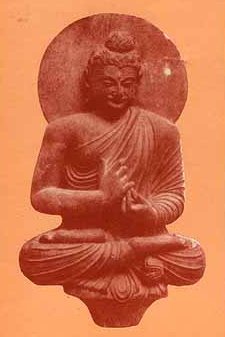Sandharana, Sandhāraṇa, Sandhārana, Samdharana: 7 definitions
Introduction:
Sandharana means something in Hinduism, Sanskrit, Buddhism, Pali, Jainism, Prakrit. If you want to know the exact meaning, history, etymology or English translation of this term then check out the descriptions on this page. Add your comment or reference to a book if you want to contribute to this summary article.
Languages of India and abroad
Pali-English dictionary
Source: BuddhaSasana: Concise Pali-English Dictionarysandhāraṇa : (nt.) checking; bearing.
Source: Sutta: The Pali Text Society's Pali-English DictionarySandhārana, (nt.) (fr. sandhāreti) checking Miln. 352. (Page 678)

Pali is the language of the Tipiṭaka, which is the sacred canon of Theravāda Buddhism and contains much of the Buddha’s speech. Closeley related to Sanskrit, both languages are used interchangeably between religions.
Sanskrit dictionary
Source: Cologne Digital Sanskrit Dictionaries: Shabda-Sagara Sanskrit-English DictionarySandhāraṇa (सन्धारण).—n.
(-ṇaṃ) Holding, observing, practising. E. sam before dhṛ to hold, lyuṭ aff.
Source: Cologne Digital Sanskrit Dictionaries: Yates Sanskrit-English DictionarySandhāraṇa (सन्धारण):—[sa-ndhāraṇa] (ṇaṃ) 1. n. Holding, practising.
Source: DDSA: Paia-sadda-mahannavo; a comprehensive Prakrit Hindi dictionary (S)Saṃdhāraṇa (संधारण) in the Sanskrit language is related to the Prakrit words: Saṃdhāraṇa, Saṃhāraṇa, Sādhāraṇā, Sāhāraṇa.
Sanskrit, also spelled संस्कृतम् (saṃskṛtam), is an ancient language of India commonly seen as the grandmother of the Indo-European language family (even English!). Closely allied with Prakrit and Pali, Sanskrit is more exhaustive in both grammar and terms and has the most extensive collection of literature in the world, greatly surpassing its sister-languages Greek and Latin.
Prakrit-English dictionary
Source: DDSA: Paia-sadda-mahannavo; a comprehensive Prakrit Hindi dictionarySaṃdhāraṇa (संधारण) in the Prakrit language is related to the Sanskrit word: Saṃdhāraṇa.
Prakrit is an ancient language closely associated with both Pali and Sanskrit. Jain literature is often composed in this language or sub-dialects, such as the Agamas and their commentaries which are written in Ardhamagadhi and Maharashtri Prakrit. The earliest extant texts can be dated to as early as the 4th century BCE although core portions might be older.
Kannada-English dictionary
Source: Alar: Kannada-English corpusSaṃdharaṇa (ಸಂಧರಣ):—
1) [noun] the act of wearing (a dress, garment, armour, etc.).
2) [noun] the act of joining, combining.
3) [noun] the act of collecting, accumulating; accumualtion.
--- OR ---
Saṃdhāraṇa (ಸಂಧಾರಣ):—
1) [noun] the act of holding or holding back.
2) [noun] the act of wearing (a dress ornament, etc.).
3) [noun] a controlling or being controlled.
4) [noun] the act or practice of observing or keeping a law, duty, custom, rule, etc.; observance.
5) [noun] the fact of possessing; possession.
6) [noun] a commiting something to memory; memorisation.
7) [noun] a protecting or being protected; protection.
Kannada is a Dravidian language (as opposed to the Indo-European language family) mainly spoken in the southwestern region of India.
See also (Relevant definitions)
Ends with: Abhisamdharana, Ahisamdharana.
Full-text: Samdharana, Samharana, Sadharana, Dharanimukhasarvajagatpranidhisamdharanagarbha, Brimhana, Sandharan, Pranasamdharana, Pratishya, Pratishyaya, Pratishyana, Sampratyeshana, Samvarana, Saharana, Abhinidhana.
Relevant text
Search found 1 books and stories containing Sandharana, Sa-ndharana, Sa-ndhāraṇa, Samdharana, Saṃdhāraṇa, Saṃdhāraṇā, Saṃdharaṇa, Sandhāraṇa, Sandhārana, Sandharaṇa; (plurals include: Sandharanas, ndharanas, ndhāraṇas, Samdharanas, Saṃdhāraṇas, Saṃdhāraṇās, Saṃdharaṇas, Sandhāraṇas, Sandhāranas, Sandharaṇas). You can also click to the full overview containing English textual excerpts. Below are direct links for the most relevant articles:
Visuddhimagga (the pah of purification) (by Ñāṇamoli Bhikkhu)
Defining of the Elements < [Chapter XI - Nutriment and the Elements (samādhi-niddesa)]
B. Description of the Five Aggregates < [Chapter XIV - The Aggregates (khandha-niddesa)]
II. Virtue < [Chapter I - Description of Virtue]